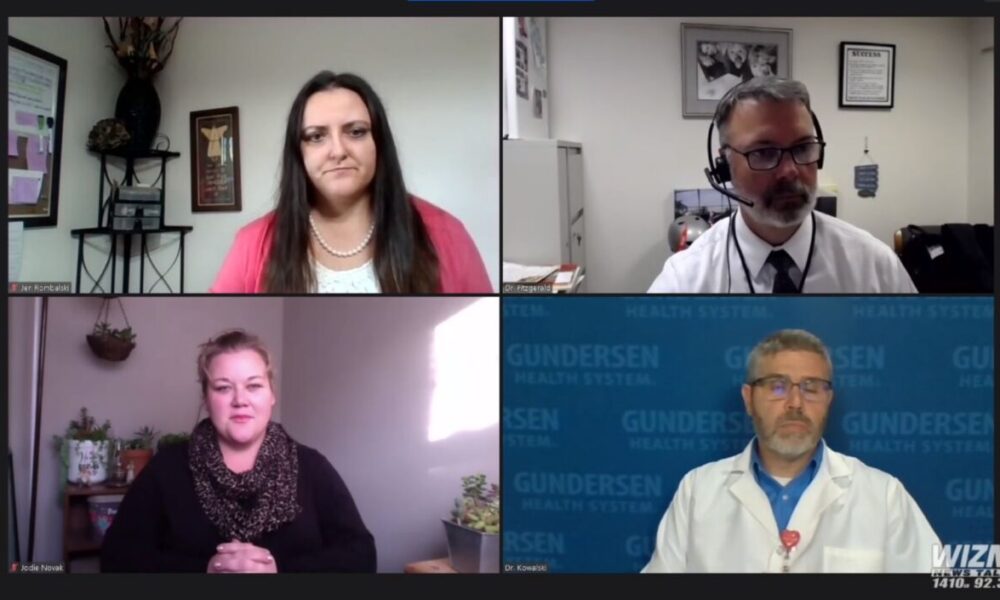Coronavirus
Doctors paint grim picture of where La Crosse hospitals are nearing due to COVID-19

Health care workers are pleading for help.
Dr. Todd Kowalski and Dr. Kevin Fitzgerald tried to convey that message Wednesday to the La Crosse community during a public health briefing.
Kowalski is an infectious disease specialist at Gundersen Health System in La Crosse. He said the numbers of COVID-19 patients coming in is staggering, and broke it down like this:
Sept. 1 — 5 COVID-19 patients
Sept. 15 — 9 patients
Oct. 1 — 17 patients
Oct. 15 — 28 patients
Nov. 1 — 40 patients
Nov. 18: — 70 patients
“We cannot sustain that pace,” Kowalski said. ‘If we continue doubling like that, it is only a matter of time before healthcare is absolutely overwhelmed.
“And we’ve been averaging, AVERAGING approximately 500 of our employees out on a daily basis because they are either under quarantine, being tested, out with the disease or having to care for family members who are.”
The two spoke during a Coulee COVID-19 Collaborative briefing, as the dashboard was updated for the week. And all but one of those metrics was in the red.

The one that wasn’t — COVID Care Capacity — was, again, in yellow. But the hospitalization rate next to it, has grown from averaging 7.1 patients per day, per 100,000 three weeks ago, to 19.6 per day last week to 27.6 per day this week.
But that “yellow” status, are the hospitals moving the goal post, so to speak, because they are converting floors to treating COVID patients. Fitzgerald, however, put that into perspective, because it can stay yellow forever with things like a 400% increase in three weeks.
“I think I’d put a little editorial around that,” he started. “We are teetering on being in the red.
“Really, when we look at what it means to be in the red, that means we’re going to be taking care of patients in tents, not in hospital beds. We’ll be transporting patients to ICUs that may be hours away. We’ll have healthcare workers that — out of necessity — will have to care for patients with active COVID, because we don’t have staff to take care of those patients.
“And, at some point, if things get bad enough, we may have to ration care. So, we may have to make really tough choices about who actually gets care and who doesn’t.
“That’s what red means, and that’s what we’re on the trajectory to get to, and we really need to change our behaviors so we can blunt the rise of this curve and hopefully turn it around to where things kind of fall a little bit.”
As the hospital continue to be flooded with COVID-19 patients, there is another problem at hand that Fitzgerald hinted at — staffing.
“That’s the huge issue right now,” he said. “You only have so many physicians, associate providers, nurses, respiratory techs, that can actually deliver care to these patients.”
Kowalski added to both of those notions.
“There is a day-to-day re-evaluation of, ‘Who can we take care of?’” he said. “And there may be a point, in all honesty, the way this is starting to erupt — not just in our community but everywhere around us — there may not be a place to send people to.
“These are all unsustainable numbers, and it’s going to, by the trajectories, clearly get worse. Almost all of these exposures to our employees are happening in the community, and it’s happening to those who we love the most.”
Of course, all this leads to the hospitals being completely dedicated to COVID-19 treatment, while everything else gets pushed back, because of how contagious the virus is.
“We will see not only deaths from COVID-19 but we’ll see deaths from other medical issues that we’re not able to address because we’re concentrating on COVID, going forward,” Fitzgerald said. “And, if things get worse, people may not get their cancer surgeries, people may not get the procedures that are really important to their overall health. And that’s what’s really waking us up in the middle of the night.”
Of course, the solutions the doctors referred back to multiple times during the briefing, are the simplest of measures and ones everyone has already heard — wear a mask, stay home, social distance, wash your hands.
Re-watch the update from November 18th, 2020 below.

Jenny
November 19, 2020 at 9:33 am
More fear propaganda from fat bureaucrats and pencil-neck government medicine men. The election-flu is a scam. Stop listening to these idiots.